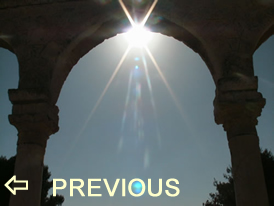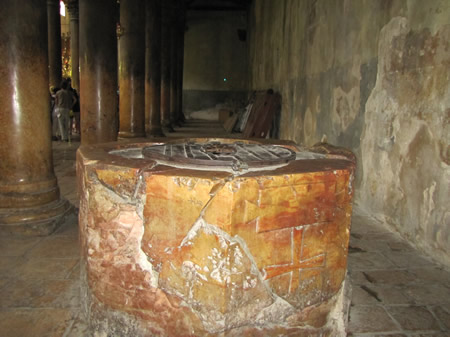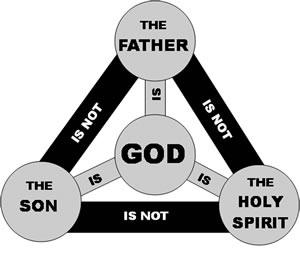|
|
|
 A Bible Teaching Ministry of Galyn Wiemers A Bible Teaching Ministry of Galyn Wiemers
|
|
|

|
| |

|
February 7 - Morning
"“Then Moses brought Aaron and his sons forward and washed them with water. He put the tunic on Aaron, tied the sash around him, clothed him with the robe and put the ephod on him. He also fastened the ephod with a decorative waistband, which he tied around him. He placed the breastpiece on him and put the Urim and Thummim in the breastpiece. Then he placed the turban on Aaron’s head and set the gold plate, the sacred emblem, on the front of it, as the Lord commanded Moses. Then Moses took the anointing oil and anointed the tabernacle and everything in it, and so consecrated them. He sprinkled some of the oil on the altar seven times, anointing the altar and all its utensils and the basin with its stand, to consecrate them. He poured some of the anointing oil on Aaron’s head and anointed him to consecrate him. Then he brought Aaron’s sons forward, put tunics on them, tied sashes around them and fastened caps on them, as the Lord commanded Moses. He then presented the bull for the sin offering, and Aaron and his sons laid their hands on its head… He then presented the other ram, the ram for the ordination, and Aaron and his sons laid their hands on its head. Moses slaughtered the ram and took some of its blood and put it on the lobe of Aaron’s right ear, on the thumb of his right hand and on the big toe of his right foot.”
- Leviticus 8:6-14; 22-23 |
 |
|
Consecration and Ordination of Aaron and the Priests |
|
|
Moses officiates for God during the ceremony of consecration and ordination of Aaron and his sons into the priesthood. Moses washed Aaron and his sons with water from the bronze basin in the Tabernacle courtyard. After washing them Moses first dresses Aaron in the priestly white tunic and over that the garments worn by the high priest: the robe and the ephod. Over the ephod was place the breastpiece with the twelve precious stones that represented the twelve tribes of Israel mounted on the front. Moses place the Urim and Thumimim into the breastplate where they would be kept for the times they were removed for inquiring of the Lord. On Aaron's head Moses placed the turban with a golden plate set on the front of the turban that said, "Holy To The Lord." (Ex 28:36; 39:30)
Once Aaron was dressed as the high priest Moses anointed the tabernacle and the furniture in the tabernacle with the oil described in Exodus 30:23-25 as perfumed oil. Then Moses went into the courtyard and anointed the altar of burnt offering, the bronze basin and all the utensils used with the altar and the basin. When the tabernacle had been anointed Moses then poured some of the oil on Aaron's head to anoint and consecrate Aaron as part of the tabernacle. The short, three verse Psalm 133 refers to this moment when Aaron was anointed with the perfumed oil that was poured out on his head:
It is like precious oil poured on the head,
running down on the beard,
running down on Aaron's beard,
down on the collar of his robe. - Ps. 133:2
Next Aaron's four sons - Nadab and Abihu, Eleazar and Ithamar (Exodus 6:23) - were dressed in the garments of the priests: white tunics secured with sashes and turbans to cover their heads.
Three sacrifices were made. The first was a bull for the sin offering of Aaron and his four sons. Aaron and his sons laid their hands on the bull to identify with it and to place their sins on the bull. The bull was then slaughtered. Blood from the bull was placed on the four horns of the altar and the rest of the blood was poured at the base of the altar. The fat portions, the kidneys and the liver were burnt on the altar. But, the rest of the bull was taken outside the camp and totally incinerated.
The second was one of two rams as a burnt offering. After Aaron and his sons laid their hands on the ram, it was slaughtered and its blood was sprinkled against the side of the altar. The ram was cut and burnt as a food offering to the Lord. Some of the meat of the ram of ordination was eaten in the Tabernacle courtyard near the gate before the Lord as a symbol of the new relationship the priests, Aaron and his sons, had with the Lord.
The third sacrifice was the second of two rams, which was offered as the ram of ordination. Some of the blood of this ram was placed on the lobe of Aaron's right ear, on the thumb of Aaron's right hand and on the big toe of Aaron's right foot. The same was done to Nadab and Abihu, Eleazar and Ithamar.
|
|
 |
"The nature of Christ’s existence is mysterious, I admit; but this mystery meets the wants of man. Reject it and the world is an inexplicable riddle – believe it; and the history of our race is satisfactorily explained."
- Napoleon Bonaparte
|
 |
“In as many days as this world was made, in so many thousand years will it be concluded…For the day of the Lord is as a thousand years. In six days created things were completed. It is evident, therefore, that they will come to an end at the sixth thousand year.” – Irenaeus, 180 AD |
|
| |
 |
|
 |
| Sheol (Hb) – Sheol (Eng) – sheol is the Hebrew word that refers to the underworld and the place of the souls of dead people. It is Hades in the Greek and includes two compartments: a place of torment waiting for judgment and a place of the righteous dead called Paradise. Sheol is not the same things as "Hell" or "Gehenna" or "the Lake of Fire" or "the Abyss" or "Tartarus." |
|
Khirbet Qeiyafa has been excavated about 19 miles SW of Jerusalem on a hill next to the Elah Valley. It is an ancient Israel city that served as a fortification on the main road from Philistia and to Coastal Plain into Jerusalem and the hill country of Judea. It is dated with many remains and artifacts from the days of David and the Temple of Solomon.
(Details here, here and here.
Photos here and here.) |
| |
|
|
 |
|
 |
Do I understand that as a believer in Jesus Christ I have been sanctified, set in the church (the body of Christ) and commissioned for service with the gifts and grace God has given to me?
I will recognize my calling and be active in serving the Lord, the body of Christ and the world. |
|
"At the window of my house I looked out through the lattice. I was among the simple, I noticed among the young men, a youth who lacked judgment. He was going down the street near her corner, walking along in the direction of her house at twilight, as the day was fading, as the dark of night set in. Then out came a woman to meet him, dressed like a prostitute and with crafty intent." - Proverbs 7:6-10 |
| |
|
|
|
|
| |
|
 |
 |
 |
 |
| Changed to be like Jesus |
Manifestation of Gifts of the Holy Spirit |
Medicare |
Water supply |
|
|
| |
 |
 |
 |
 |
| A sixth century baptismal in the Church of the nativity in Bethlehem. The pillars of Constantine's church from 339 AD can still be seen and are decorated with crusader fresco from 1000 AD. (click on image for larger size) |
A diagram explaining what the Trinity is
and what the Trinity is not.
(click on image for larger size) |
| |
|
| Details and Explanation of Sets & Reps Devotional System Here |
 |
|
|
| |
| |
| |
| Reps & Sets is a daily Bible devotional for Christians from Generation Word Bible Teaching used each morning and evening. |
| |
|
|